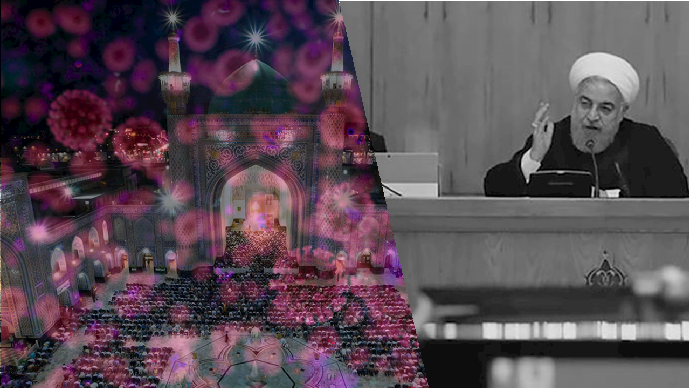Reporting by PMOI/MEK
Iran, April 27, 2020—On Friday, March 25, Iranian regime president Hassan Rouhani claimed that abidance by health protocols have been excellent and a source of pride. He then instructed the Health Minister Saeed Namaki to provide guidelines for reopening religious centers and holy shrines.
Several senior health officials warned that the coronavirus situation is not improving at all and is getting worse. But those warnings did not convince Rouhani and regime supreme leader Ali Khamenei, from revoking their decision.
Rouhani’s argument to reopen businesses was that “if the people stay home, they will die from hunger,” (which is absurd, to begin with), but what argument does he have to justify the reopening of religious centers? Why do all the mullahs insist on this?
The economic reason for reopening religious centers
The mosques and religious centers have always served as a lucrative source of business and revenue for the mullahs. Therefore, it is natural they are zealous about reopening them. In particular, holy shrines and foundations such as Astan-e Quds, Astan-e Hazrat-e Masoumeh, etc.… are the biggest source of income for the mullahs and Khamenei. The Astan-e Quds Razavi is a huge economic cartel overseen by Khamenei, with vast endowments and huge assets earned from the Imam Reza shrine. With the closure of these centers, Khamenei and the ruling mullahs will lose billions of dollars. The mullahs estimate that pilgrimages and donations to shrines will increase during the COVID-19 crisis, and they’re losing a huge opportunity to profit by keeping these sites closed. The month of Ramadan adds to this and the Eid al-Fitr market is important for the mullahs’ businesses. The Ramazan and Moharam bazaars are important as well and the mullahs cannot give up these huge benefits.
The political and social reason
Furthermore, the Friday prayer stages are of political and social importance for the mullahs. The Friday prayers are the most important tribune of the Iranian regime. It is mainly through these events that the regime promotes its policies and gives guidelines to its forces. With the cancellation of Friday prayers, the regime will be deprived of this socio-political and propaganda leverage. In addition, around mosques and religious centers, the regime establishes spying and suppression networks consisting of Basij, eulogists, and plainclothes agents. Mosques are the main centers for its suppressive forces and their closure is a big blow for the regime.
A choice between potential and immediate risk
Since the reopening of religious centers and allowance of rallies in them will cause a terrible outbreak and spread of coronavirus, the question is, aren’t Khamenei and Rouhani worried about the catastrophic consequences of this decision? Don’t they consider the danger?
The answer is simple. Khamenei and Rouhani have decisively chosen the economic and the security of their regime above the lives of the people. Khamenei said in his remarks on April 9: “Production must resume whatever the price” which means he will use the crisis as a tool against the collapse of his regime and does not care how many will die as a result of his decision. Khamenei and Rouhani try to maintain their regime and deem it more important than anything else. In the same speech Khamenei downplayed the COVID-19 crisis and framed it as insignificant, saying, “In comparison to other problems, this is very small,” and added, “We should also not neglect the conspiracies and enmity of the Arrogant Powers.”
The main issue for the Khamenei is to maintain his regime and the reopening mosques play an important role in the regime’s security structure. Therefore, it is natural that while the regime is facing a threat from the Iranian people and their organized resistance the mosques and religious centers are reopened, “whatever the price.”
The regime fears the high numbers of death due to COVID-19 as a potential security risk, but the immediate and actual danger is the army of the poor and unemployed. The regime has chosen between the bad and the worse. Rouhani recently said, “coronavirus is a disease, but unemployment is a bigger threat, mortality from corona should not be curbed, while death from poverty and unemployment could rises.”
To be clear, the regime had another choice, which was to tap into its vast financial resources to continue to support the people while quarantines continued. Institutions such as Astan-e Quds, Mostazafan Foundation, Setad, and other financial bodies overseen by Khamenei have the wealth to cover the costs of people’s lives during the lockdown. But the regime’s leaders have opted to keep a hold on their wealth and spend it on their destructive agendas such as launching military satellites and funding terrorism abroad.
As the Iranian Resistance has announced, To protect their regime against the threat of uprisings, Rouhani and Khamenei have adopted the strategy of sending people back to work at the price of high human casualties. This decision runs in parallel to the policy of regime founder Ruhollah Khomeini, who engaged in an eight-year war with Iraq and killed more than a million people to prevent the collapse of his rule.
But the regime cannot run away from the consequences of this crime. As the regime’s own officials are warning, the post-coronavirus era will be tumultuous, and social protests will be even more intense and violent than in previous years.





